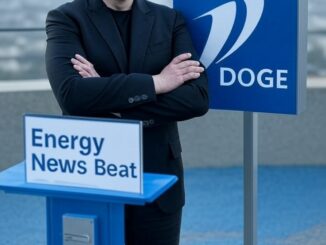
The artificial intelligence (AI) boom is reshaping industries, from healthcare to finance, but it’s also igniting an unprecedented surge in electricity demand. Data centers powering AI models like those from OpenAI and Google are consuming energy at rates not seen since the post-World War II era, with projections indicating a need for tens of gigawatts of additional capacity in the coming years.
As America races to maintain its edge in AI innovation, the key question is how to meet this demand affordably and sustainably. This article explores the trade-offs involved in delivering the lowest-cost kilowatt-hour (kWh) to consumers and businesses while minimizing environmental harm, drawing on recent analyses and expert insights.
The Scale of the AI Energy Challenge
AI’s energy appetite is voracious. Training a single large language model can require as much electricity as thousands of households, and with inference—the everyday use of AI—scaling up, data centers are at the epicenter. According to the International Energy Agency (IEA), global electricity demand from data centers could more than double to 945 terawatt-hours (TWh) by 2030, with a significant portion driven by AI.
Are you Paying High Taxes in New Jersey, New York, or California?
In the U.S., electricity demand is projected to grow 25% by 2030 from 2023 levels, largely fueled by AI and data centers.
More aggressive estimates suggest AI data centers alone could require up to 130 gigawatts (GW) of capacity by 2030, equivalent to adding the power needs of millions of homes.
This growth outpaces current infrastructure development. The Federal Energy Regulatory Commission (FERC) has tripled its forecasts for U.S. power demand by 2030, highlighting the strain on grids.
Companies like Anthropic project that the U.S. AI sector will need at least 50 GW by 2028 just for training and inference, underscoring the urgency.
Without strategic planning, blackouts, higher costs, or delayed AI advancements could result.
In the Secretary Chris Wright interview on Stuart Varney, Chris was spot on in discussing the need to implement power sources that can survive without subsidies.
Secretary Chris Wright is on target – Wind works when the Wind blows, and Solar works when the sun shines, and we need baseline power today.
Evaluating Energy Sources: Costs and Emissions
To power this revolution, America must weigh a mix of energy sources. The levelized cost of electricity (LCOE)—a measure of the average net cost over a plant’s lifetime—varies widely, as does environmental impact, measured in grams of CO2 equivalent (CO2e) per kWh.

Sources: LCOE from Lazard’s 2025 report and EIA Annual Energy Outlook 2025; emissions from IPCC, Wikipedia lifecycle assessments, and other analyses. And I have yet to find one LCOE that includes end-of-life land reclamation or recycling included. There are an estimated 79,000 wind turbines in the United States, which amounts to about an $ 80 billion liability for land reclamation.
Renewables like solar and wind offer the lowest LCOE, making them attractive for cost savings. Utility-scale solar, even without tax credits, can deliver electricity at $0.038-$0.078 per kWh, undercutting many fossil fuels. However, what is not factored into the LCOE is the additional nameplate base load required to balance the grid. Take ERCOT in Texas as an example; they have about 90 GW of power required, but they have 180 GW of wind, solar, storage, natural gas, and nuclear. This is because the wind does not blow all of the time, and the sun does not shine 24/7. So the additional cost of the 110 GW is not ever talked about in any formulas.
Their low emissions—solar at 41 g CO2e/kWh versus coal’s 820 g—align with environmental goals. We are not here to defend coal, but the base load coal provides must be maintained for longer until wind and solar technologies can be improved.
Nuclear power, with emissions comparable to wind (12 g/kWh), provides reliable, round-the-clock power but at higher costs due to regulatory hurdles and construction delays. The Trump administration has several programs it is fast-tracking in the nuclear space, and we are watching to see how many years they can pull these projects forward and online sooner.
Natural gas, emitting 490 g/kWh, bridges the gap with mid-range costs and high reliability.
Trade-Offs: Balancing Cost, Reliability, and the Environment
Achieving the lowest-cost kWh with minimal environmental impact requires navigating tough trade-offs. Cost vs. Reliability: Renewables are cheap but intermittent—solar energy is generated only during daylight, requiring expensive battery storage to ensure 24/7 AI operations. Adding batteries can double LCOE, pushing solar setups toward $100/MWh or more.
Natural gas offers reliability at a moderate cost but locks in fossil fuel dependence. Nuclear is ultra-reliable but costly upfront; small modular reactors (SMRs) could reduce this, but they’re not yet scaled.
Environmental Impact vs. Speed: To minimize CO2, prioritize renewables and nuclear, which emit far less than gas or coal. However, building renewable infrastructure quickly could involve land use trade-offs, like habitat disruption for solar farms. Fossil fuels enable faster deployment—gas turbines are “sold out” through 2030 due to demand—but increase emissions, potentially exacerbating climate change.
A full shift to low-emission sources might raise short-term costs for consumers if grids falter.
Equity and Accessibility: Lowest-cost kWh for everyone means avoiding price spikes. Over-reliance on intermittent sources could lead to volatility, while a diverse mix stabilizes rates. Environmentally, underserved communities often bear the brunt of pollution from fossil plants, so transitioning to cleaner sources reduces health impacts but requires investment in grid upgrades.
The sweet spot? An “all-of-the-above” strategy: 60-70% renewables for cost and emissions savings, backed by 20-30% nuclear for baseload, and gas as a transitional fuel. This could deliver kWh at under $0.05 on average while cutting emissions by 50% from current levels.
Pathways Forward: Solutions and Policies
America can power the AI revolution through innovation, partnerships, and smart policy.
Infrastructure Acceleration: Follow Anthropic’s roadmap by leasing federal lands for data centers and streamlining permits under the National Environmental Policy Act (NEPA).
This cuts delays, enabling rapid deployment of solar-battery arrays in the Southwest or nuclear restarts.
Technological Mix: Invest in SMRs (0.1 GW each) for compact, low-emission power near data centers. Reverse coal retirements temporarily while scaling geothermal and hydro where feasible.
AI itself can optimize grids, reducing waste by 10-15% through predictive algorithms.
Policy Reforms: Minimize regulatory friction to let markets drive solutions. Use DOE loan guarantees for transmission and establish National Interest Electric Transmission Corridors in high-demand areas.
Incentives like tax credits can lower LCOE for renewables, ensuring affordability.
Public-private partnerships are crucial. Big Tech’s investments—billions in energy plans—can fund clean projects, but oversight ensures benefits reach all Americans.
Conclusion: A Sustainable Power Play
Powering the AI revolution isn’t just about keeping the lights on; it’s about forging a future where innovation thrives without compromising the planet or pocketbooks. By embracing a balanced energy mix—leveraging the lower advertised costs of renewables, the reliability of nuclear, and the speed of transitional fuels—America can achieve sub-$0.05/kWh electricity with emissions slashed to near-zero fossil fuel levels in the future, when technology allows. The trade-offs are real, but with proactive policies and collaboration, the U.S. can lead the world in AI while setting a global standard for sustainable energy.
The time to act is now, before demand outstrips supply, and keep the coal and natural gas plants online while technology is updated. Until recycling for windmill blades and solar panels is ramped up, they cannot be truly “sustainable” even by their own definition. Until then, fossil fuels and nuclear power will continue to keep the lights on, and wind and solar will be additional, albeit expensive, sources of energy added to the grid when you add the additional 110% name plate sources nobody bothers to calculate in, or the end-of-life for solar panels and wind turbines.
Avoid Paying Taxes in 2025
Crude Oil, LNG, Jet Fuel price quote
ENB Top News
ENB
Energy Dashboard
ENB Podcast
ENB Substack






